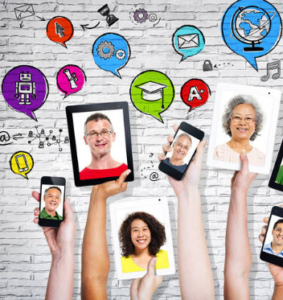There is little doubt that the internet is changing learning in very interesting yet significant ways. Would you agree? For more than several decades, educators have strived to customize education to the learner. Enter connected learning concepts. Connected learning leverages the advances of the digital age to make that dream much more of a reality. It is about creative social media for learning as one component of the internet age learning toolset.

Good author resources for creative social media topic includes John Jantsch and Brian Solis.
Check out our thoughts on creative marketing.
More to learn Facebook Statistics … Lots to Learn From Current Data
But let’s step back for a moment to elaborate on connected learning and its relationship to the internet and social media.
Related: Why Questioning is Critical to Learning and Problem Solving
Let’s start by establishing a common definition of connected learning. Connected learning is a type of learning that integrates personal interest, peer relationships, and achievement in academic, civic, or career-relevant areas. In addition, connected learning is an approach to educational reform keyed to the abundance of information and social connection brought about by networked and digital media.
Advocates of connected learning point out that this approach leverages the internet to broaden access to opportunity and meaningful learning experiences. The connected learning model suggests that people learn best when: they are interested in what they are learning; they have peers and mentors who share these interests; their learning is directed toward opportunity and recognition.
What do you think … so far, so good?
A set of principles for connected learning were developed by a group of researchers, technology makers, philanthropists, and educational practitioners seeking to come together around a common approach for how to expand educational opportunity in the digital age.
At the core of connected learning are three values: equity, full participation, and social connection.
Connected learning is further defined by the following three learning principles and three design principles. Let me discuss these six principles of connected learning that allow everyone to experience learning that is social, participatory, interest-driven, and relevant to the opportunities of the internet and social media:
Creative social media … interest powered
Interests foster the drive to gain knowledge and expertise. Research has repeatedly shown that when the topic is personally interesting and relevant, learners achieve much higher-order learning outcomes. Connected learning views interests and passions that are developed in a social context as essential elements.

Peer-supported
Connected learning thrives in a socially meaningful and knowledge-rich ecology of ongoing participation, self-expression, and recognition.
In their everyday exchanges with peers and friends, young people fluidly contribute, share and give feedback. Powered with possibilities made available by today’s social media, this peer culture can produce learning that’s engaging and powerful.
Academically oriented
Educational institutions are centered on the principle that intellectual growth thrives when learning is directed towards intellectual growth, achievement, and excellence. Connected learning recognizes the importance of academic success for intellectual growth and as an avenue towards economic and political opportunity.
Social media list for learning with shared purpose
Connected learning environments are populated with adults and peers who share interests and are contributing to a common purpose. Cross-generational learning and connection thrive when centered on common interests and goals.
About social media … production centered
Connected learning prizes the learning that comes from actively producing, creating, experimenting, and designing because it promotes skills and dispositions for lifelong learning and for making meaningful contributions to today’s rapidly changing work and social conditions.

Openly networked
Connected learning environments link learning in school, home and community because learners achieve best when their learning is reinforced and supported in multiple settings.
Online platforms can make learning resources abundant, accessible and visible across all learner settings.”
One of my favorites in this field is John Seely Brown. Brown or as he is often called—JSB—is the Independent Co-Chairman of the Deloitte’s Center for the Edge and a visiting scholar and advisor to the Provost at University of Southern California (USC). A master integrator and instigator of productive friction, JSB explores the whitespace between disciplines and builds bridges between disparate organizations and ideas.
His life before that was equally interesting. In this life, he was the Chief Scientist of Xerox Corporation and the director of its Palo Alto Research Center (PARC)—a position he held until June 2000. In his more than two decades at PARC, Brown transformed PARC into a truly multidisciplinary research center at the creative edge of applied technology and design.
It was known for integrating social sciences and arts into the traditional physics and computer science research and expanding the role of corporate research to include topics such as the management of radical innovation, organizational learning, complex adaptive systems, and nano-technologies. He was also a co-founder of the Institute for Research on Learning (IRL). His personal research interests include digital youth culture, digital media, and the application of technology to fundamentally rethink the nature of work.
– See more at: http://spotlight.macfound.org/featured-stories/entry/john-seely-brown-beyond-creativity-cultivate-imagination/#sthash.sHmAOuAf.dpuf
Taking his past interests and infusing new interests, Brown has done some very valuable work with connected learning. He has shared lessons those interested in improving learning can take away from surfers, gamers, and artists on how passion and competitive hunger can drive intrinsic motivation.
Brown believes connected learning honors the desire to have curiosity and imagination. That’s why creating environments to help learners find their interests is such an important step. Interest-driven learning honors curiosity and imagination. Those are 21-st century skills. Notice, though, that enhanced curiosity and the ability to tinker and play with systems is rarely mentioned as a critical 21st-century skill. Very odd, don’t you think?
Let’s examine Brown’s intriguing results from his studies of surfers in Hawaii to illustrate the concepts of connected learning. He found that these surfers create their own cohorts and engage in almost everything we talk about in connected learning. They are constantly learning from one another. If you figure out a new move on a surfboard and win a competition because of it, you can’t patent it. That move will be copied within almost 48 hours around the entire world because of things like YouTube.
As Brown notes, they are global learners. And they’re engaging in some deep innovation. What are their strategies for innovation? They don’t just look at other surfers. They look at all kinds of adjacent activities, such as windsurfing, skateboarding, motor cross racing, and mountain biking. Their curiosity is radically extended. This brings the subject back to imagination. His belief is that we’re way too focused on creativity. It’s misguided. He believes the more important focus goal should be on imagination.
See more at http://spotlight.macfound.org/featured-stories/entry/john-seely-brown-beyond-creativity-cultivate-imagination/#sthash.sHmAOuAf.dpuf
Would you like to learn more about Brown and connected learning? See his book A New Culture of Learning, where he and Douglas Thomas pursue an understanding of how the forces of change, and emerging waves of interest associated with these forces, inspire and invite us to imagine a future of learning that is as powerful as it is optimistic. Our understanding of what constitutes “a new culture of learning” is based on several basic assumptions about the world and how learning occurs:
The world is changing more rapidly than ever
Our skill sets have an ever shorting life
An understanding play is critical to understanding learning
The connected world is an awesome resource if we take advantage
In this connected world, mentorship takes on new importance and meaning
Challenges we face are multi-faceted requiring true systems thinking & perspectives
Skills are important but so are mindsets and dispositions
Innovation is more important than ever – but turns on our ability to cultivate imagination
The culture of learning needs to leverage social & technical infrastructures in new ways
The play is the basis for cultivating imagination and innovation
By exploring play, innovation, and the cultivation of the imagination as cornerstones of learning, the authors create a vision of learning for the future that grows along with the technology that fosters it and the people who engage with it.
More details: 6 Fantastic Facts about the Changing Social Media Landscape
A result is a new form of culture in which knowledge is seen as fluid and evolving. The ability to manage, negotiate and participate in the world is governed by the play of the imagination.
Key takeaways
Social media, the internet, and connected learning offer a great deal to let people customize their own learning. Connected learning leverages the advances of the digital age to make that dream much more of a reality. Social media for learning is one of the best components of the internet age learning toolset.
Lots to look forward to, isn’t there?
Lots of ideas here that can be easily replicated … which ones do you feel could benefit your business?
How could you improve the Starbucks Coffee Social Media campaign concept for your business?

